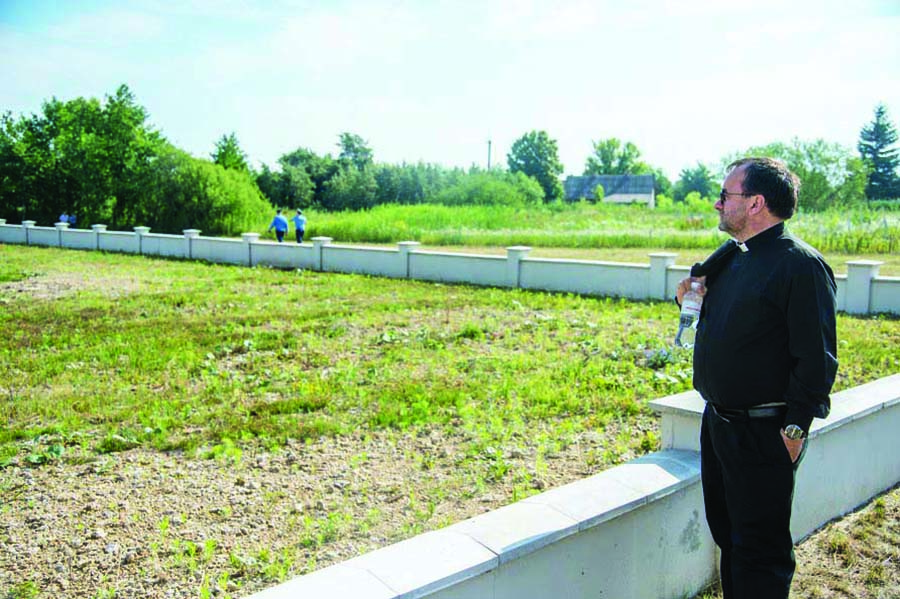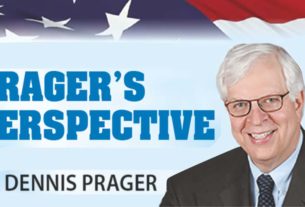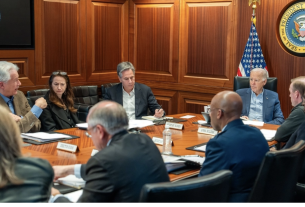Photo Credit: Patrick Desbois

Treblinka, Auschwitz, Belzec, Sobibor, Dachau. The Nazi concentration and death camps loom large in Jewish memory. Less remembered are the mass graves in Eastern Europe at the edge of which the Nazis shot 2.2 million Jews. Indeed, many are unknown.
Patrick Desbois wants to change that. A Catholic priest, Desbois founded an organization called Yahad – In Unum in 2004, which is dedicated to finding and documenting all the mass shootings of Jews and Roma during World War II.
‘);
_avp.push({ tagid: article_top_ad_tagid, alias: ‘/’, type: ‘banner’, zid: ThisAdID, pid: 16, onscroll: 0 });
But Desbois is not just interested in where the Jews were killed. He wants to know exactly how they were killed. Who rounded them up? Who drove them to the mass grave sites? Who dug the pits? Who cooked lunch for the Nazis doing the shooting? No detail is too small for Desbois in documenting what he calls the “Holocaust by Bullets.” To that end, he and his team of investigators travel throughout Eastern Europe interviewing elderly non-Jews who witnessed these mass shootings.
Desbois is the recipient of the Legion d’honneur (France’s highest honor), the former head of the Commission for Relations with Judaism of the French Bishops’ Conference, and the author of three books that have appeared in English translation, including In Broad Daylight: The Secret Procedures behind the Holocaust by Bullets, which was published last year. He is currently in New York for a fundraising event where The Jewish Press interviewed him.
The Jewish Press: What is your organization doing right now?
Desbois: We are finishing finding all the mass graves. Right now, we have one team in Estonia and another team in Ukraine. We need another two or three years to finish finding all of them.
How many mass graves has your organization discovered?
I don’t know. [Editor’s note: His assistant later said the number is 2,700.] Himmler and Heidrich were very worried about how many millions were killed. But I work for families. I don’t work for millions.
Many families write to us and ask us, “In which mass grave is my father buried?” Nobody asks, “In which mass grave are my millions buried?”
In your book “In Broad Daylight,” you write that some of the elderly non-Jews you interview actually helped the Nazis kill the Jews by driving them to the killing site, digging the mass graves, filling them up with dirt afterwards, etc. What was it like sitting across from these people?
We interview anybody who was present at the killing in order to rebuild the crime and establish evidence because Holocaust deniers are getting stronger and stronger and the survivors will disappear. So we work to establish, crime by crime, what the Germans and the neighbors did to kill the Jews.
We have interviewed and recorded 7,000 people so far.
Some of the people you interviewed clearly feel guilty about what happened – but others do not. Is it difficult speaking to such people?
There is no genocide without the [participation of the neighbors], so Hitler used the neighbors wherever he could. And there were 22 jobs for each killing.
He used the Soviet system. In the Soviet Union, you requisitioned workers, and the people couldn’t say no. Hitler didn’t care if you were guilty or not. He wanted to deport all these people to the east anyways. If he had won the war, all these countries would be German colonies. So he didn’t care.
What were the 22 jobs?
The first thing needed was diggers – people to dig the mass grave. Then you needed food and people to bring the food to the diggers. After that, you need people to surround the ghetto [to prevent anyone escaping right before they were taken to the mass killing site]. Normally the local police of the village did that, but it also could be German civilians or others.
These shootings were done with [the help of] local people, but nobody mentions it because the neighbors have never been interviewed. We are the first organization to interview the neighbors.
You write that some of these neighbors actually spoke Yiddish to you.
Yes, because Yiddish was a common language. There were Jewish collective farms in the Soviet Union, so the farmers working with the Jews learned Yiddish. In the Soviet Union, there were actually many minority villages – German villages, Armenian villages, Jewish villages – and each village spoke its own language. The story of the Jewish colonies is very unknown in America.
When you discover previously unknown mass graves, do you erect monuments on the sites?
No, because we want to finish on time. We’re still missing 500,000 Jews on a continent of extermination that extended from Lithuanian to Azerbaijan. We know [from archival records] that the Germans shot around 2.2 million. We’ve found [the final resting places] of 1.5 million, so we’re still missing approximately 500,000. And we’re running against time because the witnesses are old and we want to finish before they die.
How do we judge the moral guilt of people who, under coercion, dug the mass graves, drove Jews to the site, etc.?
My question is not the guilt. We are here to establish the evidence of the crime, so if a guy was working [for the] Gestapo or something like that, he’s my best witness. I want to know the crime and the location of the corpses because anti-Semitism is coming back, and we must also protect the corpses.
Why do you do what you do?
I don’t know. I do what I have to do. I’m not alone. My team consists of 29 people full time. And I have five investigation teams. They are young people and we do what we have to do. It has to be done. [The Nazis] killed more than two million Jews, and nobody cares.
Even in the Jewish memories, it hasn’t stayed. People remember Auschwitz but not the shootings. The shootings were public and nobody remembers, and Auschwitz was secret and everybody remembers. One victim in three was shot.
In your book, you write that some of the people in these villages where Jews were rounded up and killed saw their execution as punishment for killing their savior 2,000 years ago. In the 1960s, the Catholic Church officially declared that present-day Jews aren’t responsible for his death, but some argue that this message hasn’t filtered down to the lower classes. What’s your opinion?
It’s complicated; the Catholic Church is nearly non-existent in Russian and Ukraine. Most people are Christian Orthodox, and not all churches made the same revolution toward the Jews.
So the attitude of a lower-class rural Christian in Eastern Europe today may be similar to what it was 75 years ago?
I don’t know. You must understand, we have no time. It’s like if you interviewed a policeman working against gangs in Los Angeles and you asked him what the attitude of the priests in Los Angeles is. He would say, “I have no time.”
We have no time. I understand your question. It’s important. But we have no time to study that.
<!–
Publisher #16: JewishPress.com
Zone #113: Comment Banner / (02) / News
Size #15: Banner 468×60 (Comments and Mobile) [468×60]
–> ‘);
_avp.push({ tagid: article_top_ad_tagid, alias: ‘/’, type: ‘banner’, zid: ThisAdID, pid: 16, onscroll: 25 });



